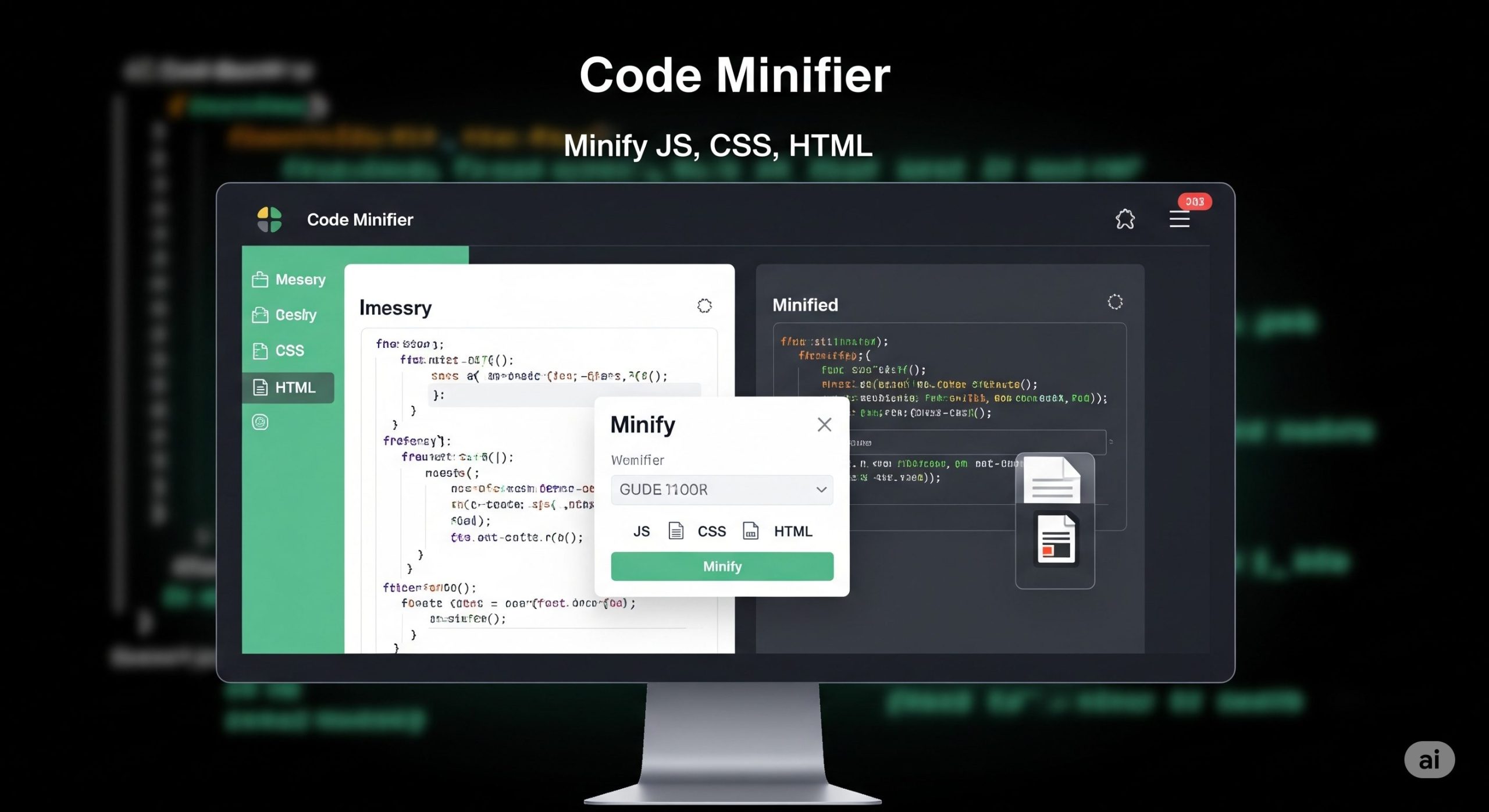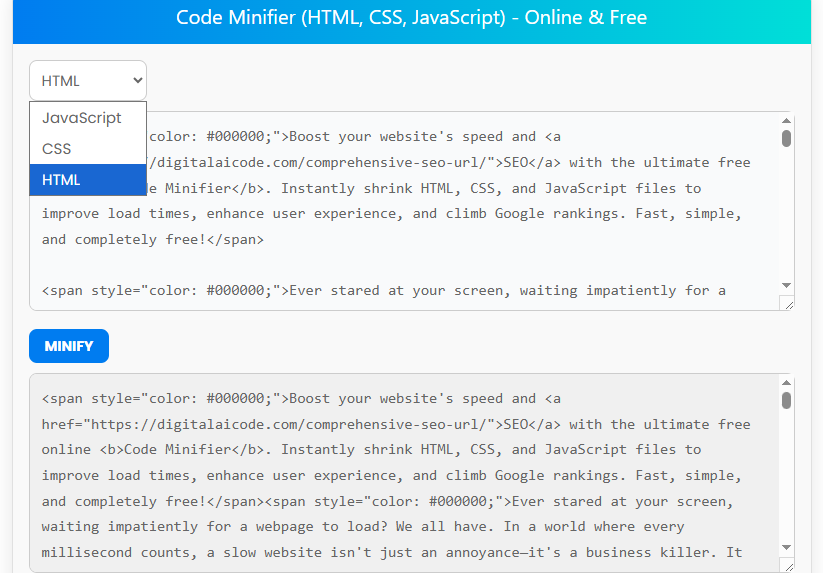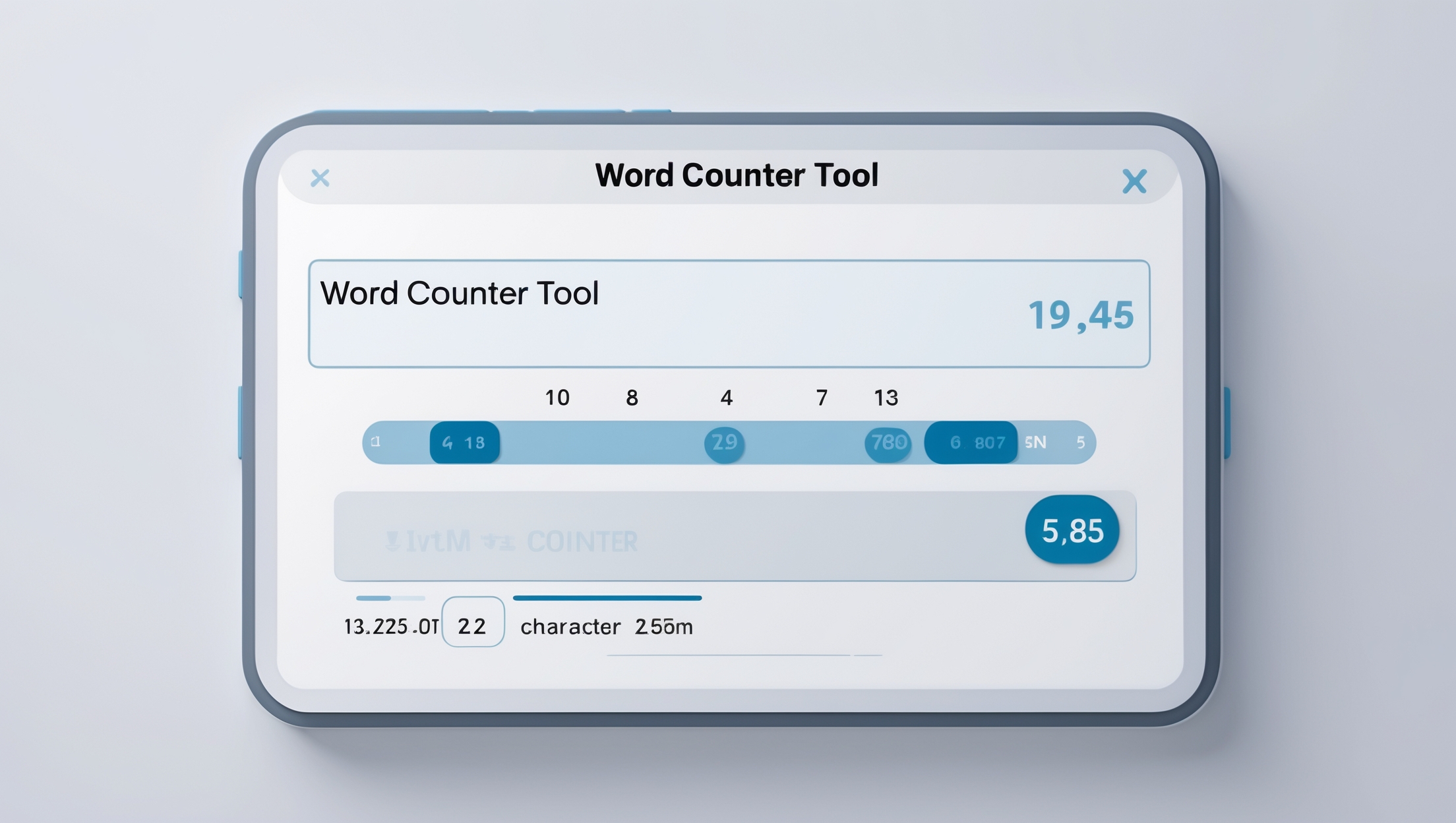Boost your website’s speed and SEO with the ultimate free online Code Minifier. Instantly shrink HTML, CSS, and JavaScript files to improve load times, enhance user experience, and climb Google rankings. Fast, simple, and completely free!
Ever stared at your screen, waiting impatiently for a webpage to load? We all have. In a world where every millisecond counts, a slow website isn’t just an annoyance—it’s a business killer. It drives visitors away, sinks your conversion rates, and tells search engines like Google that your site offers a poor user experience. But what if you had a secret weapon to fight back? A simple, powerful tool that could instantly make your site faster, leaner, and more beloved by both users and Google?

Enter the Code Minifier. This isn’t some complex, expensive software. It’s a straightforward, free online tool designed to do one thing exceptionally well: streamline your website’s code for maximum performance. Whether you’re a seasoned developer, a small business owner managing a WordPress site, or a student just starting your coding journey, understanding and using a Code Minifier is one of the most impactful changes you can make.
In this comprehensive guide, we’ll dive deep into the world of code minification. You’ll learn what it is, why it’s crucial for modern web performance and SEO, and exactly how to use our powerful online Code Minifier to optimize your HTML, CSS, and JavaScript files in seconds. Get ready to leave your slow-loading competitors in the dust.
What is a Code Minifier and Why is it Your Website’s Best Friend?
At its core, a Code Minifier is a tool that programmatically removes all unnecessary characters from source code without changing its functionality. Think of it like a professional editor for your code. When developers write code, they add comments, indentation, and extra spaces (collectively known as whitespace) to make it readable and maintainable for humans.
Here’s a simple example in CSS:
Before Minification (Human-Readable):
CSS
/* Style for the main button */
.main-button {
color: white;
background-color: #007bff;
padding: 10px 20px;
}
After Minification (Machine-Readable):
CSS
.main-button{color:#fff;background-color:#007bff;padding:10px 20px}
Both versions do the exact same thing. The browser understands them perfectly. However, the minified version is significantly smaller in file size. While a few bytes saved on one style rule might seem trivial, imagine this process applied to thousands of lines of HTML, CSS, and JavaScript across your entire website. The savings add up—fast.
So, why is this your website’s best friend?
- Drastically Reduced Page Load Times: Smaller files mean faster downloads. When a user visits your site, their browser has to download all the HTML, CSS, and JS files. By using a Code Minifier, you shrink these files, leading to a noticeable improvement in how quickly your pages render.
- Enhanced User Experience (UX): Speed is a cornerstone of good UX. Visitors are far more likely to stay, engage, and convert on a site that feels snappy and responsive. A fast site feels professional and reliable.
- Improved SEO Rankings: Google has explicitly stated that page speed is a ranking factor for both desktop and mobile searches. By improving your site speed with a Code Minifier, you’re directly addressing key metrics in Google’s Core Web Vitals, such as Largest Contentful Paint (LCP). A faster site leads to better rankings, which means more organic traffic.
- Lower Bandwidth Consumption: Smaller files save bandwidth for both your server and your visitors. This is especially crucial for users on mobile devices or with limited data plans, making your site more accessible to a wider audience.
In short, using a Code Minifier is one of the easiest and most effective ways to optimize your website for the modern web.
The Core Components: A Deep Dive into Our Online Code Minifier
Our free online Code Minifier is a versatile tool that handles the three core languages of the web. It’s not just one tool, but a suite of three powerful optimizers rolled into one simple interface. Let’s break down how each component works.
The HTML Minifier: Cleaning Up Your Structure
HTML (HyperText Markup Language) forms the skeleton of your webpages. While it might not seem as complex as JavaScript, unoptimized HTML files can still contain plenty of unnecessary whitespace and comments left over from development.
Our HTML Minifier intelligently scans your markup and:
- Removes all HTML comments (“).
- Strips extra whitespace between elements.
- Collapses multiple spaces into one where appropriate.
This ensures your site’s structure is delivered to the browser in the most compact form possible, trimming precious kilobytes and speeding up the initial rendering of your page.
The CSS Minifier: Streamlining Your Styles
CSS (Cascading Style Sheets) controls the visual presentation of your website. As sites grow, CSS files can become bloated with comments, indentation, and redundant declarations.
The CSS Minifier module is specifically designed to tackle this. It refines your stylesheets by:
- Eliminating all comments (
/* ... */). - Removing whitespace and line breaks.
- Condensing code around brackets (
{}), colons (:), and semicolons (;).
The result is a lean, mean stylesheet that loads instantly and applies visual rules without delay, preventing issues like “Flash of Unstyled Content” (FOUC) and contributing to a better Cumulative Layout Shift (CLS) score.
The JavaScript Minifier: Optimizing Your Logic
JavaScript powers the interactive and dynamic elements of your site, from image sliders and pop-ups to complex web applications. It’s often the largest and most performance-critical part of a modern website.
Our JavaScript Minifier focuses on making your scripts lighter and faster by:
- Stripping out single-line (
//) and multi-line (/* ... */) comments. - Removing unnecessary whitespace and line breaks.
This process reduces the file size of your scripts, leading to faster parsing and execution times by the browser. A well-optimized script using a JavaScript Minifier can significantly improve your site’s First Input Delay (FID), making your page feel more responsive to user interactions. For developers looking for even more advanced optimization, this tool provides a perfect first step before integrating into more complex pipelines using automated build tools like Webpack which can perform further optimizations like variable renaming.
How to Use Our Free Code Minifier: A Simple Step-by-Step Guide
We designed our Code Minifier with simplicity in mind. You don’t need to install any software or have any technical expertise. Just follow these four easy steps.
Step 1: Select Your Code Type Using the dropdown menu, choose the type of code you want to minify: HTML, CSS, or JavaScript. This ensures the correct set of rules is applied for optimal results.

Step 2: Paste Your Code Copy your original, unminified code and paste it into the “Input” text box on the left.
Step 3: Click the “Minify” Button Press the prominent “Minify” button. Our tool will instantly process your code. The minified, optimized version will appear in the “Output” text box on the right. You’ll also see helpful stats showing the original size, the new size, and how much space you’ve saved.
Step 4: Copy and Use Your Optimized Code Click the “Copy” button to save the minified code to your clipboard. You can now paste this optimized code back into your project files, replacing the original. That’s it! Your website is now one step closer to lightning-fast performance.
Minification vs. Compression (Gzip/Brotli): What’s the Difference?
This is a common point of confusion, but it’s crucial to understand. Minification and compression are not the same thing, but they work together as a powerful team.
- Minification is a pre-processing step. You minify your code before you upload it to your server. It permanently removes unnecessary characters from the file itself. Our Code Minifier is a tool for this stage.
- Compression (like Gzip or Brotli) is a server-level optimization. When a user’s browser requests a file, your server compresses it on the fly before sending it. The browser then decompresses it. The original file on the server remains unchanged. You can learn more about this process from authoritative sources on server-level compression like Gzip or Brotli.
The Golden Rule: You should always do both! Minify your files first to make them as small as possible. Then, enable Gzip or Brotli compression on your server. This two-step process ensures your files are delivered to the end-user in the smallest, fastest way imaginable, maximizing your performance gains.
The Best Free Online Code Minifier for Your 2025 Projects
In today’s competitive digital landscape, performance is not a luxury—it’s a necessity. A slow website is a liability, but thankfully, optimizing your site’s code has never been easier. Our free online Code Minifier provides a simple, accessible, and powerful solution for developers and site owners of all skill levels.
By streamlining your HTML, CSS, and JavaScript, you’re not just shedding a few kilobytes. You’re investing in a better user experience, stronger SEO signals, and a more professional online presence. You’re building a website that respects your visitors’ time and performs flawlessly on any device.
Bookmark this page. Make our Code Minifier a regular part of your development workflow. Take the first step towards a faster, more successful website today. Your users—and your Google ranking—will thank you for it.
Frequently Asked Questions (FAQ)
What exactly is code minification?
Code minification is the process of removing all non-essential characters from source code without altering its functionality. This includes whitespace, comments, and line breaks. The goal is to reduce the file size, which leads to faster website load times.
Is using a Code Minifier safe for my website?
Yes, it is very safe when done correctly. A reliable Code Minifier, like ours, only removes characters that are unnecessary for the code to execute. However, it’s always a best practice to keep a backup of your original, unminified code, just in case you need to debug or edit it later.
Does this tool store my code?
Absolutely not. We prioritize your privacy and security. All processing is done in your browser. Your code is never sent to or stored on our servers. Once you close the page, it’s gone forever.
How does an HTML, CSS, or JavaScript Minifier directly improve SEO?
Search engines, especially Google, use page speed as a key ranking factor. By using an HTML Minifier, CSS Minifier, and JavaScript Minifier, you significantly reduce file sizes. This improves your site’s load time, which directly boosts your scores for Google’s Core Web Vitals (CWV). Better CWV scores can lead to higher search engine rankings and more organic traffic.


